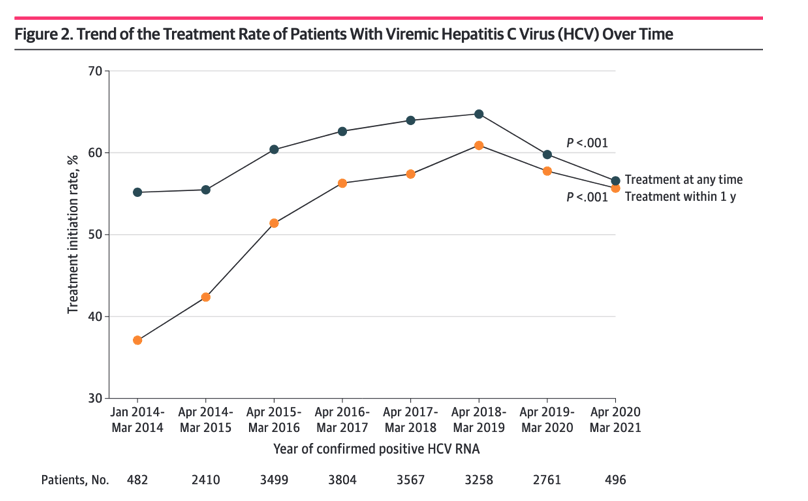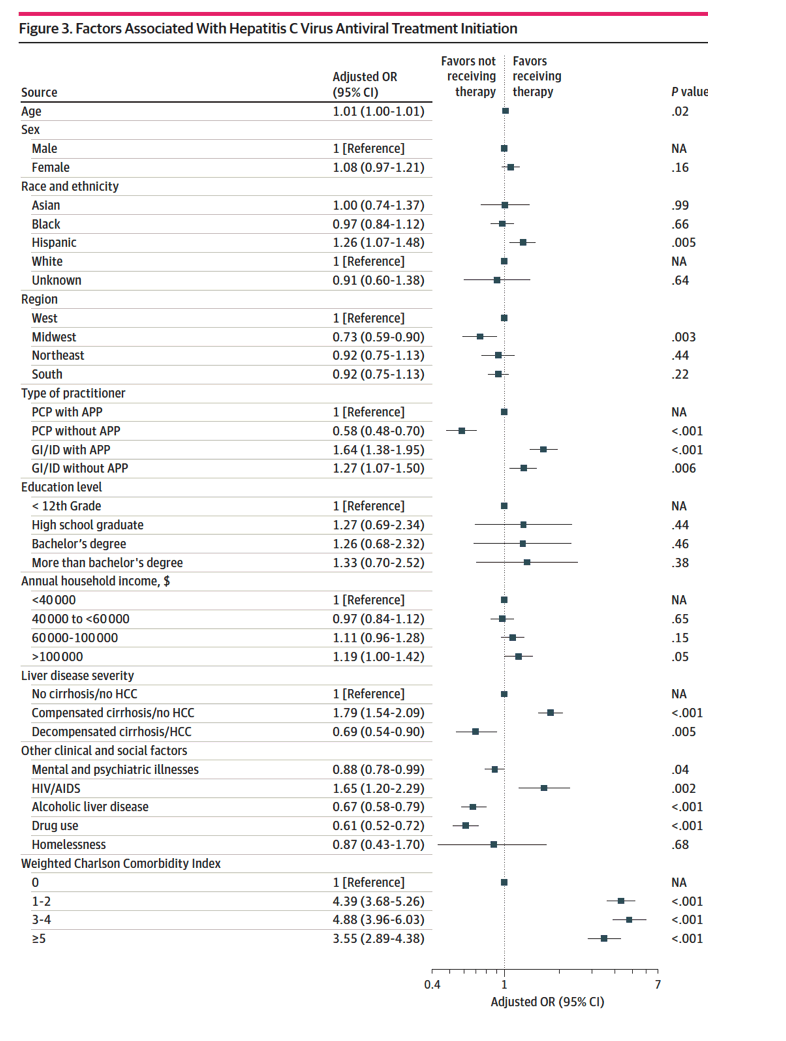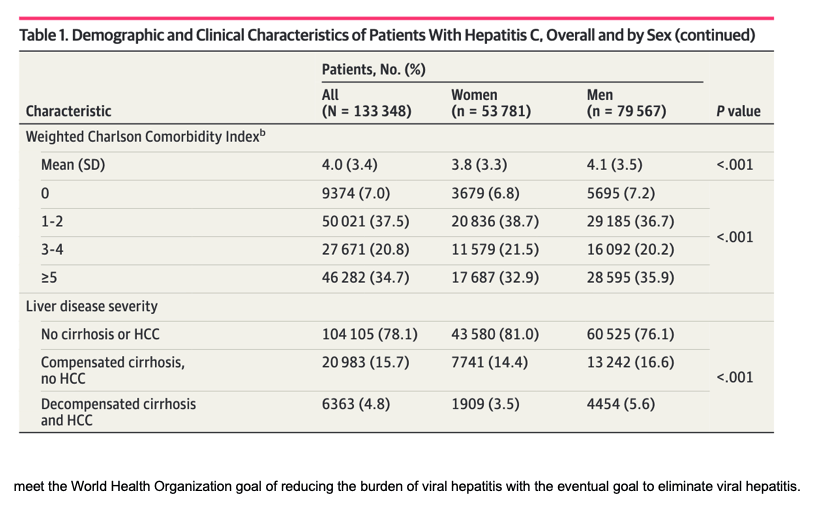| |
Characteristics and Treatment Rate of Patients With Hepatitis C Virus Infection in the Direct-Acting Antiviral Era and During the COVID-19 Pandemic in the United States
|
| |
| |
Download the PDF here
December 7, 2022
Conclusions and Relevance: In this cohort study, less than two-thirds of insured patients with viremic HCV received DAA treatment, with declines in both the treatment rate and the number of viremic HCV diagnoses since 2019 and especially during the COVID-19 pandemic. Further efforts are needed to increase HCV diagnosis and treatment, especially for those with cirrhosis and HCC. An urgent call for nationwide actions to improve access to DAA treatment, community outreach programs, and specialists through referral pipelines is needed in the United States to stay on track to meet the World Health Organization goal of reducing the burden of viral hepatitis with the eventual goal to eliminate viral hepatitis.
Discussion
In this nationwide US study of insured HCV patients conducted between 2014 and 2021, we found
suboptimal treatment rates for patients with viremic HCV infection, especially since the beginning of
the COVID-19 pandemic. We found a high cure rate of approximately 97% among patients treated
with DAAs, regardless of what kind of clinician provided care. However, less than two-thirds of all
We also found significant differences in the distribution of HCV infection across US regions, with
half of the study cohort receiving care in the South. This finding may also reflect the impact of the
opioid epidemic in igniting a dramatic increase of HCV cases, as most new HCV cases have been
observed in persons who inject drugs and there has been a steep 364% increase in acute HCV cases
among young adults in 4 Appalachian states in the South between 2006 and 2012. 38,39 We also
found that patients who received care in the Midwest were 30% less likely to be associated with
receiving DAA treatment compared with those receiving care in the West, after adjusting for race and
ethnicity, income, education level, and liver disease severity.
Another important observation in the current study is the 30% lower likelihood of receiving
DAA therapy among patients with decompensated cirrhosis and/or HCC despite the finding that
among patients with decompensated cirrhosis or HCC who received treatment, 95% achieved SVR.
These results highlight the need to expand awareness that patients with advanced disease should be
prioritized to receive treatment and not the reverse, as in addition to our study, other multiple large
and well-controlled studies have shown improved liver function and survival with HCV cure with DAA
in patients with decompensated liver cirrhosis and/or HCC. 41-44
Key Points
Question How has the treatment rate for hepatitis C virus infection with direct-acting antivirals (DAAs) changed over time?
Findings In this cohort study of 20 277 patients with viremic hepatitis C and private health insurance in the United States, as of 2020, there was a suboptimal DAA treatment rate of 65.2% and a declining treatment rate beginning in 2019.
Patients with hepatocellular carcinoma and decompensated cirrhosis were 30% less likely to receive DAA treatment than those without either condition.
Meaning These findings suggest that DAA treatment remains underutilized, as only 2 of 3 patients eligible received treatment.
Abstract
Importance Clinical data on hepatitis C virus (HCV) treatment rates in the United States are sparse.
Objective To evaluate HCV treatment rates in the era of direct-acting antivirals (DAAs).
Design, Setting, and Participants This retrospective cohort study used data from the deidentified Optum Cliniformatics Data Mart Database (2014-2021) on patients with HCV in the DAA and COVID-19 eras. The database includes patients with private health insurance in the US.
Main Outcomes and Measures The treatment rate and changes over time were assessed with adjusted log-binomial regression, and factors associated with treatment were examined using multivariable logistic regression.
Results A total of 133 348 patients with HCV (79 567 [59.7%] men; mean [SD] age, 59.7 [12.3] years; 4448 [3.3%] Asian, 24 662 [18.5%] Black, and 74 750 [56.1%] White individuals) were included; 38 180 (26.8%) had HCV RNA data, and of those, 20 277 (53.1%) had positive HCV RNA.
Overall, 13 214 patients with positive HCV RNA tests (65.2%) received DAA treatment; 6456 of 6634 patients treated with DAAs (97.3%) achieved sustained virologic response.
After adjusting for age, sex, and race and ethnicity, the treatment rate in 2018 was 0.5 times greater than the rate in 2014 (adjusted prevalence ratio, 1.50; 95% CI, 1.42-1.59) but declined after 2018, decreasing from 64.8% to 61.2%, and especially after 2019, when it decreased to less than 60% (P < .001).
The number of patients with viremic HCV identified in between April 2020 and March 2021 also decreased to 496 from 2761 and 3258 in the preceding 2 years.
Receiving care from a gastroenterologist or infectious disease specialist with advanced care practitioner (ie, nurse practitioner, physician assistant, or clinical nurse specialist) was independently associated with greater odds of DAA treatment (adjusted odds ratio [aOR], 1.64; 95% CI, 1.07-1.50).
Patients with decompensated cirrhosis and/or hepatocellular carcinoma (HCC) were 31% less likely to receive treatment compared with those without (aOR, 0.69; 95% CI, 0.54-0.90).
Conclusions and Relevance In this cohort study, less than two-thirds of insured patients with viremic HCV received DAA treatment, with declines in both the treatment rate and the number of viremic HCV diagnoses since 2019 and especially during the COVID-19 pandemic. Further efforts are needed to increase HCV diagnosis and treatment, especially for those with cirrhosis and HCC. An urgent call for nationwide actions to improve access to DAA treatment, community outreach programs, and specialists through referral pipelines is needed in the United States to stay on track to



| |
| |
| |
|
|
|